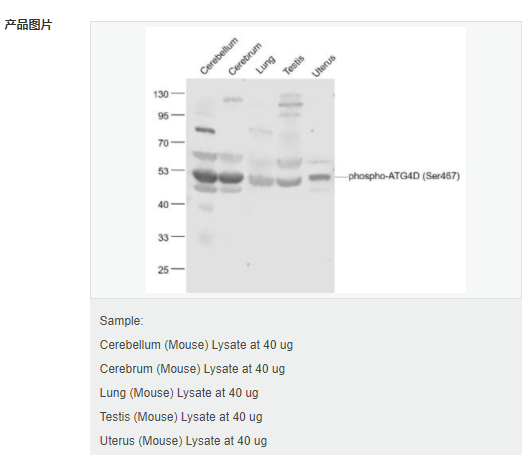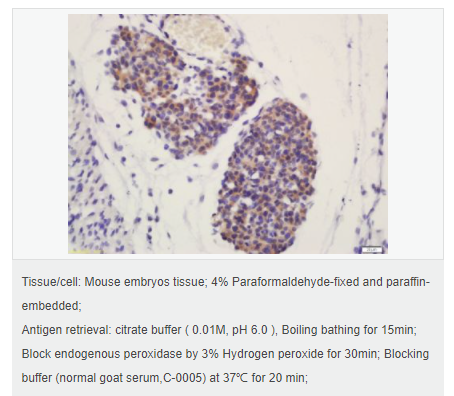

貨號
產品規格
售價
備注
BN41053R-100ul
100ul
¥2470.00
交叉反應:Mouse(predicted:Human,Rat,Dog,Pig,Cow,Horse,Rabbit) 推薦應用:WB,IHC-P,IHC-F,IF,ELISA
產品描述
| 英文名稱 | phospho-ATG4D (Ser467) |
| 中文名稱 | 磷酸化自噬相關蛋白4D抗體 |
| 別 名 | ATG4D (phospho-S467); 9830134P12Rik; APG4 autophagy 4 homolog D; APG4 D; APG4, S. cerevisiae, homolog of, D; APG4D; ATG4 autophagy related 4 homolog D (S. cerevisiae); Atg4d; ATG4D_HUMAN; Atg4dl; AUT like 4 cysteine endopeptidase; AUT-like 4 cysteine endopeptidase; AUTL4; Autophagin 4; Autophagin-4; autophagy 4, S. cerevisiae, homolog of, D; autophagy related 4D, cysteine peptidase; Autophagy related cysteine endopeptidase 4; Autophagy related protein 4 homolog D; Autophagy-related cysteine endopeptidase 4; Autophagy-related protein 4 homolog D; Cysteine protease ATG4D; Cysteine protease involved in autophagy; MGC31226. |
| 產品類型 | 磷酸化抗體 |
| 研究領域 | 腫瘤 信號轉導 細胞凋亡 |
| 抗體來源 | Rabbit |
| 克隆類型 | Polyclonal |
| 交叉反應 | Mouse, (predicted: Human, Rat, Dog, Pig, Cow, Horse, Rabbit, ) |
| 產品應用 | WB=1:500-2000 ELISA=1:5000-10000 IHC-P=1:100-500 IHC-F=1:100-500 IF=1:100-500 (石蠟切片需做抗原修復) not yet tested in other applications. optimal dilutions/concentrations should be determined by the end user. |
| 分 子 量 | 53kDa |
| 細胞定位 | 細胞漿 |
| 性 狀 | Liquid |
| 濃 度 | 1mg/ml |
| 免 疫 原 | KLH conjugated Synthesised phosphopeptide derived from human ATG4D around the phosphorylation site of Ser467:RP(p-S)SE |
| 亞 型 | IgG |
| 純化方法 | affinity purified by Protein A |
| 儲 存 液 | 0.01M TBS(pH7.4) with 1% BSA, 0.03% Proclin300 and 50% Glycerol. |
| 保存條件 | Shipped at 4℃. Store at -20 °C for one year. Avoid repeated freeze/thaw cycles. |
| PubMed | PubMed |
| 產品介紹 | Autophagy is the process by which endogenous proteins and damaged organelles are destroyed intracellularly. Autophagy is postulated to be essential for cell homeostasis and cell remodeling during differentiation, metamorphosis, non-apoptotic cell death, and aging. Reduced levels of autophagy have been described in some malignant tumors, and a role for autophagy in controlling the unregulated cell growth linked to cancer has been proposed. This gene belongs to the autophagy-related protein 4 (Atg4) family of C54 endopeptidases. Members of this family encode proteins that play a role in the biogenesis of autophagosomes, which sequester the cytosol and organelles for degradation by lysosomes. Alternative splicing results in multiple transcript variants. [provided by RefSeq, Jul 2013] Function: Cysteine protease ATG4D: Cysteine protease required for the cytoplasm to vacuole transport (Cvt) and autophagy. Cleaves the C-terminal amino acid of ATG8 family proteins MAP1LC3 and GABARAPL2, to reveal a C-terminal glycine. Exposure of the glycine at the C-terminus is essential for ATG8 proteins conjugation to phosphatidylethanolamine (PE) and insertion to membranes, which is necessary for autophagy. Has also an activity of delipidating enzyme for the PE-conjugated forms. Cysteine protease ATG4D, mitochondrial: Plays a role as an autophagy regulator that links mitochondrial dysfunction with apoptosis. The mitochondrial import of ATG4D during cellular stress and differentiation may play important roles in the regulation of mitochondrial physiology, ROS, mitophagy and cell viability. Subcellular Location: Cysteine protease ATG4D: Cytoplasm. Cysteine protease ATG4D, mitochondrial: Cytoplasm. Mitochondrion matrix. Note=Imported into mitochondrial matrix after cleavage by CASP3 during oxidative stress and cell death. Tissue Specificity: Mainly expressed in skeletal muscle and, to a lower extent, in testis. Post-translational modifications: Cleaved by CASP3 during apoptosis which leads to increased activity. The cleavage by CASP3 reveals a cryptic mitochondrial targeting sequence immediately downstream of their canonical caspase cleavage sites which leads to mitochondroal import of the protein. Similarity: Belongs to the peptidase C54 family. SWISS: Q86TL0 Gene ID: 84971 Database links: Entrez Gene: 84971 Human Entrez Gene: 235040 Mouse Omim: 611340 Human SwissProt: Q86TL0 Human SwissProt: Q8BGV9 Mouse Unigene: 512799 Human Unigene: 440165 Mouse Unigene: 202643 Rat Important Note: This product as supplied is intended for research use only, not for use in human, therapeutic or diagnostic applications |

